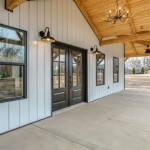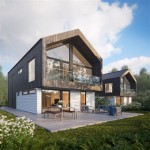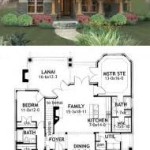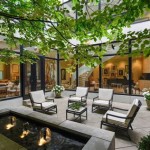Modern concrete house plans prioritize architectural innovation, sustainability, and enduring beauty. These plans utilize the versatility of concrete to create contemporary structures that embrace sleek lines, open spaces, and an integration with the surrounding environment. For instance, a modern concrete house plan might incorporate vast expanses of glass to maximize natural light, while its geometric forms and exposed concrete surfaces lend a distinctive aesthetic.
The flexibility offered by concrete allows architects to push boundaries in design. Its structural strength enables cantilevered structures, soaring ceilings, and intricate detailing. Moreover, concrete’s inherent durability and low maintenance make it an ideal choice for those seeking a long-lasting, low-cost home. The enduring appeal of concrete houses lies not only in their aesthetic qualities but also in their functional advantages.
In this article, we delve into the intricate details of modern concrete house plans, exploring the design principles, construction techniques, and environmental considerations that shape these remarkable structures. We will uncover how architects harness the unique properties of concrete to create inspiring and sustainable living spaces.
Modern concrete house plans offer a myriad of advantages, making them a popular choice for discerning homeowners. Here are 8 key points to consider:
- Durable and resilient
- Energy efficient
- Fire resistant
- Versatile design options
- Low maintenance
- Sustainable and eco-friendly
- Cost-effective in the long run
- Aesthetically pleasing
These attributes make modern concrete house plans an excellent investment for those seeking a stylish, comfortable, and sustainable home.
Durable and resilient
Modern concrete house plans prioritize durability and resilience, ensuring that your home can withstand the test of time and nature’s elements. Concrete is renowned for its exceptional strength and longevity, making it an ideal choice for building structures that can endure harsh weather conditions, such as high winds, heavy rainfall, and earthquakes.
Unlike traditional building materials like wood or brick, concrete does not rot, warp, or succumb to termite infestations. Its inherent resistance to fire and pests adds an extra layer of protection, giving you peace of mind and reducing the need for costly repairs and maintenance.
Furthermore, concrete’s thermal mass helps regulate indoor temperatures, keeping your home cool in summer and warm in winter. This reduces energy consumption and creates a more comfortable living environment.
With proper maintenance, a modern concrete house can last for generations, providing a secure and durable shelter for you and your family.
The durability and resilience of modern concrete house plans make them an excellent choice for those seeking a low-maintenance, long-lasting home that can withstand the rigors of daily life and environmental challenges.
Energy efficient
Modern concrete house plans prioritize energy efficiency, reducing your carbon footprint and utility bills. Concrete’s thermal mass acts as a natural insulator, absorbing and releasing heat slowly. This helps maintain a stable indoor temperature, reducing the need for heating and cooling systems.
Additionally, the airtight construction methods used in modern concrete houses minimize heat loss and air leakage, further enhancing energy efficiency. By incorporating energy-efficient windows, doors, and appliances, you can create a home that consumes less energy and contributes to a greener environment.
Furthermore, the use of passive solar design principles in modern concrete house plans optimizes natural light and heat gain. Large windows and skylights strategically placed to capture sunlight can reduce the need for artificial lighting and heating during the day.
By embracing energy-efficient design strategies, modern concrete house plans offer a sustainable and cost-effective living environment, minimizing your impact on the planet while reducing your energy expenses.
The energy efficiency of modern concrete house plans makes them an excellent choice for eco-conscious homeowners seeking to reduce their environmental impact and enjoy lower energy costs.
Fire resistant
Modern concrete house plans prioritize fire resistance, providing peace of mind and enhanced safety for you and your family. Concrete is a naturally fire-resistant material, offering superior protection against the spread of flames and smoke.
Unlike wood and other combustible materials, concrete does not burn or contribute to the spread of fire. Its high thermal mass helps prevent the rapid spread of heat, giving occupants valuable time to evacuate in case of a fire.
Concrete’s fire resistance is particularly important in areas prone to wildfires or regions with strict fire safety regulations. By choosing a modern concrete house plan, you can rest assured that your home will provide a safe haven in the event of a fire.
Additionally, concrete’s durability and strength ensure that the structural integrity of your home remains intact even after exposure to fire. This can minimize the extent of damage and facilitate easier repairs, potentially saving you time and money in the long run.
The fire resistance of modern concrete house plans makes them an excellent choice for homeowners prioritizing safety and peace of mind. By choosing concrete, you can create a home that provides a secure and protective environment for your family and belongings.
Versatile design options
Modern concrete house plans offer unparalleled versatility in design, allowing you to create a home that perfectly aligns with your unique style and lifestyle.
Concrete’s moldability and structural strength make it possible to achieve intricate architectural details, curves, and cantilevered structures. This opens up a world of design possibilities, from minimalist and modern to organic and sculptural forms.
Architects can incorporate large expanses of glass to maximize natural light and create a seamless connection between indoor and outdoor spaces. Concrete’s ability to support heavy loads allows for the creation of soaring ceilings, mezzanines, and dramatic staircases.
Furthermore, concrete’s adaptability extends to its surface finishes. It can be cast with various textures, colors, and patterns, allowing you to create a home that reflects your personal aesthetic. Whether you prefer polished concrete floors, exposed aggregate walls, or decorative concrete panels, the design options are virtually limitless.
The versatile design options of modern concrete house plans empower you to create a home that is not only structurally sound and durable but also a true reflection of your individuality and creativity.
Low maintenance
Modern concrete house plans are renowned for their low maintenance requirements, making them an ideal choice for busy homeowners and those seeking a hassle-free living environment.
- Durable and long-lasting
Concrete is an exceptionally durable material that can withstand the elements and daily wear and tear. Unlike wood or steel, concrete does not rot, rust, or warp, requiring minimal upkeep over its lifetime.
- Resistant to pests and moisture
Concrete’s non-porous surface and lack of organic materials make it resistant to pests, insects, and moisture damage. This eliminates the need for regular pest control treatments and reduces the risk of mold and mildew growth.
- Easy to clean and maintain
Concrete surfaces are easy to clean and maintain. Regular sweeping or mopping is sufficient to keep them looking their best. Unlike carpets or wooden floors, concrete does not require waxing, polishing, or refinishing.
- Cost-effective in the long run
Although the upfront cost of building a concrete house may be higher than traditional materials, its low maintenance requirements and durability can lead to significant savings in the long run. Reduced repair and replacement costs, as well as lower energy bills due to concrete’s thermal mass, make concrete houses a cost-effective investment.
The low maintenance requirements of modern concrete house plans make them an excellent choice for homeowners seeking a practical and low-maintenance lifestyle, freeing up time and resources for more enjoyable pursuits.
Sustainable and eco-friendly
Modern concrete house plans embrace sustainability and eco-friendliness, contributing to a greener and healthier living environment.
- Reduced carbon footprint
Concrete is a durable and long-lasting material, reducing the need for frequent renovations and replacements. This lowers the embodied carbon emissions associated with construction and minimizes the environmental impact over the building’s lifetime.
- Energy efficiency
Concrete’s thermal mass helps regulate indoor temperatures, reducing energy consumption for heating and cooling. Additionally, modern concrete house plans often incorporate energy-efficient features such as passive solar design, natural ventilation, and high-performance windows, further minimizing the carbon footprint.
- Recyclable materials
Concrete is largely composed of recycled materials, such as fly ash and slag, reducing the demand for virgin resources. Additionally, concrete structures can be deconstructed and recycled at the end of their lifespan, promoting circularity and minimizing waste.
- Improved indoor air quality
Concrete does not emit harmful VOCs (volatile organic compounds) or toxins, contributing to a healthier indoor environment. Its non-porous surface also reduces the accumulation of dust and allergens, improving air quality and promoting well-being.
By incorporating sustainable practices and eco-friendly materials, modern concrete house plans support a responsible and environmentally conscious lifestyle, reducing the impact on the planet while enhancing the health and well-being of occupants.
Cost-effective in the long run
Modern concrete house plans offer significant cost savings in the long run due to their durability, low maintenance, and energy efficiency.
- Durability and longevity
Concrete is an exceptionally durable material that can withstand harsh weather conditions, pests, and daily wear and tear. This reduces the need for frequent repairs and replacements, lowering maintenance costs and extending the lifespan of the house.
- Low maintenance requirements
Concrete surfaces are easy to clean and maintain, requiring minimal upkeep. Unlike traditional materials such as wood or brick, concrete does not require painting, staining, or sealing, saving time and money on maintenance.
- Energy efficiency
Concrete’s thermal mass helps regulate indoor temperatures, reducing energy consumption for heating and cooling. Additionally, modern concrete house plans often incorporate energy-efficient features such as passive solar design and high-performance windows, further lowering energy bills.
- Increased resale value
The durability, low maintenance, and energy efficiency of concrete houses make them highly desirable in the real estate market. As a result, concrete houses tend to hold their value well and may even appreciate at a higher rate than homes built with traditional materials.
By considering the long-term savings on maintenance, repairs, and energy costs, modern concrete house plans prove to be a cost-effective investment, providing homeowners with a comfortable and sustainable living environment while minimizing financial burdens over time.
Aesthetically pleasing
Modern concrete house plans embrace the unique aesthetic qualities of concrete, showcasing its versatility and beauty. Concrete’s inherent strength allows for the creation of bold architectural forms, sharp angles, and expansive open spaces. Its malleability enables architects to mold concrete into sculptural elements, such as curved walls, cantilevered structures, and intricate details.
The raw and industrial character of concrete provides a striking contrast to other materials, adding a touch of urban sophistication to residential designs. Concrete’s natural gray hue and textured surfaces can be complemented by warm wood accents, lush greenery, and vibrant colors, creating a harmonious and visually appealing blend of materials.
Furthermore, modern concrete house plans often incorporate large expanses of glass, blurring the boundaries between indoor and outdoor spaces. Floor-to-ceiling windows and skylights flood the interiors with natural light, showcasing the interplay of light and shadow on concrete’s surfaces. This creates a sense of spaciousness and connectivity with the surrounding environment.
The aesthetic appeal of modern concrete house plans extends beyond its visual qualities. The raw and unpretentious nature of concrete conveys a sense of authenticity and timelessness. Its ability to age gracefully, developing a patina over time, adds to its charm and character. Concrete’s versatility and adaptability make it a perfect canvas for personal expression, allowing homeowners to create unique and visually stunning living spaces that reflect their individual style and aspirations.
The aesthetically pleasing qualities of modern concrete house plans make them highly sought after by discerning homeowners who appreciate the beauty and versatility of this remarkable material. Concrete’s ability to blend seamlessly with other materials, its sculptural potential, and its timeless appeal contribute to the enduring popularity of concrete architecture.










Related Posts








